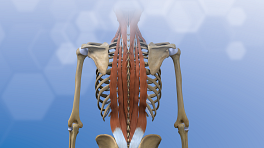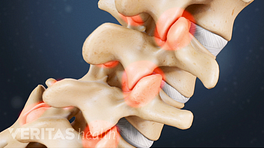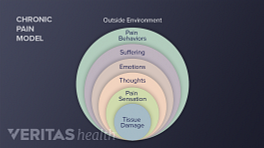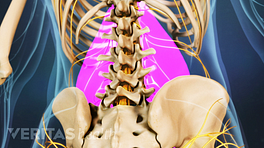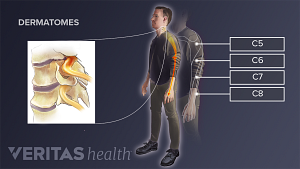Strategies to address back pain vary widely, depending on the type of pain as well as other factors.
Learning about the major types of back pain can be helpful for people with back pain who are considering their treatment options. The medical community typically places back pain in one of the following categories:
In This Article:
When Pain Is Clear-Cut: Nociceptive Pain
The type of pain most people know best is called nociceptive pain. Our body has sensors, called nociceptors, which spot potentially harmful stimuli. These receptors alert us to an injury to a muscle, soft tissue (ligaments, tendons), bones, joints, or skin (or other organs). Pain signals are then relayed to the brain and the central nervous system, resulting in a feeling of pain. Nociceptive pain is also called somatic pain.
Nociceptive pain is often described as a deep aching, throbbing, gnawing, or soreness. Common examples of nociceptive pain related to back pain include pain after trauma, such as back pain after a car accident or a fall; pain after back surgery; and arthritis pain. Nociceptive pain is usually localized and eases as the injury heals.
When Nerves Malfunction: Neuropathy
Sciatica is a symptom of nerve pain in the back.
Pain caused by damage or injury to the nerve tissue is called neuropathy, or neuropathic pain. Nerve damage can result from an infection or injury elsewhere in the body. It is not known why some injuries lead to neuropathy, while others do not. Once the damage is done, the nerves continue to send pain signals long after the original injury has healed.
See Treatment Options for Neuropathic Pain
Sciatica is a symptom of back-related neuropathic pain. It occurs when something presses against a nerve root in the lower back, triggering pain and numbness along the sciatic nerve, stretching from the buttocks to the feet. Other examples include pain that travels from the spine down the arm, and pain that persists after back surgery.
See What You Need to Know About Sciatica
It is thought that some cases of prolonged nociceptive pain may progress to neuropathy.
Acute vs. Chronic Pain
Within the categories of nociceptive and neuropathic pain, pain can be further broken down into acute and chronic pain, which differ greatly in form and function:
- With acute pain, the severity of pain is tied to the level of tissue damage. The body has a protective reflex to avoid this kind of pain: the reflex to pull back quickly after touching a sharp object. Acute pain is a sign of injured or diseased tissue; when the underlying problem is cured, the pain goes away. Acute pain is a form of nociceptive pain.
- Chronic pain does not serve a protective or other helpful biological function. Instead, the nerves continue to send pain messages after the earlier tissue damage has healed. Neuropathy is a type of chronic pain.


